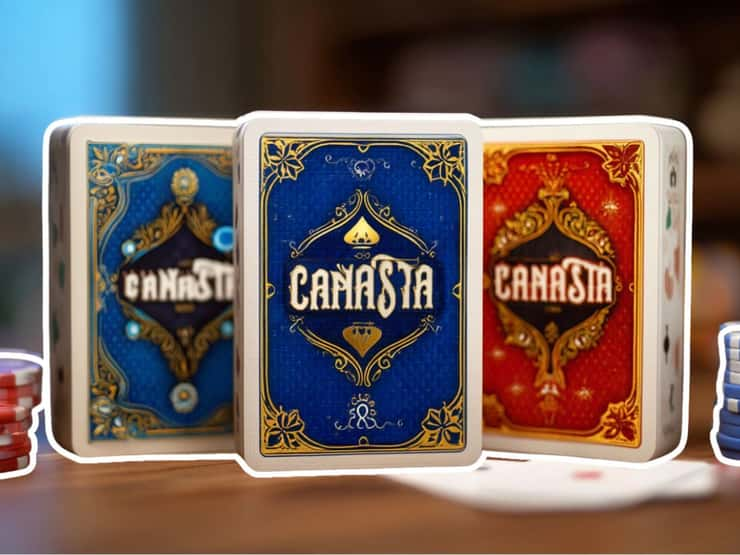Canasta
Learn Canasta rules, how to play, and fun variations. Master melds, canastas, and strategy tips in this classic card game.
✍️ September 10, 2025
If you’ve ever thought card games peaked with Rummy, Canasta is here to prove you wrong. This 1950s classic is all about teamwork, clever melding, and the occasional “gotcha” moment when your opponent realizes you’ve been saving that seventh card for a canasta.
Don’t worry if the scoring system looks like math homework at first glance—once you get the hang of it, Canasta flows fast and can be seriously addictive. Whether you’re playing in pairs or just going head-to-head, it’s one of those games that balances strategy with just enough chaos to keep things exciting.
👉 If you like strategic, partnership-based games, Pinochle is another classic that mixes bidding, melding, and trick-taking for a satisfying mental challenge.
How to Play Canasta
The goal is simple: be the first team (or player) to hit 5,000 points by melding sets of cards and creating canastas. Each turn is about drawing, melding, and discarding, all while managing your hand like a pro.
1. Get the decks ready
Shuffle two full decks of cards together (Jokers included). Deal 11 cards to each player, then place the rest face down as the stockpile. Flip one card over to start the discard pile.
2. Know your objective
Score points by forming melds (three or more of the same rank) and canastas (seven of the same rank). The first to reach 5,000 wins.
3. Draw a card
On your turn, take one card from the stock or the entire discard pile (with conditions). You’ll need this to build melds.
4. Make your melds
Lay down sets of three or more cards of the same rank. Natural melds (no wilds) are worth more than those with wild cards.
5. Go for canastas
Stack up seven or more cards of the same rank to form a canasta. A natural canasta scores 500 points, while a mixed one scores 300.
6. Discard to end your turn
Finish by discarding one card. Keeping track of what you throw away is crucial—your opponents are watching.
7. Go out
When one player empties their hand, the round ends. Tally up scores and start again until someone hits 5,000.
👉 For a faster, more chaotic option, Uno Flip adds a two-sided twist that can turn any calm game into instant chaos.
Canasta Rules
Canasta rules are where skill meets sneakiness. To play smart, focus on timing, hand management, and paying attention to your opponents.
1. Prioritize natural canastas
They score higher, so avoid wasting wild cards unless you absolutely need them.
2. Watch the discard pile
Sometimes grabbing the discard pile can swing the whole round—but only if it actually helps your melds.
3. Track your opponents
Notice which ranks they’re discarding or collecting. That knowledge helps you decide what’s “safe” to throw.
4. Don’t rush to go out
Going out ends the hand, but sometimes you’re better off holding back to score a few extra melds first.
5. Use red threes wisely
They’re automatic bonus points, but remember they can’t be melded. Drop them right away when you draw them.
6. Manage your wild cards
Jokers and twos are powerful, but if you burn through them too early, you’ll regret it later.
Canasta Variations
One of the best things about Canasta is how flexible it is. Over the years, players have invented fun twists that keep the game fresh.
1. Two-Handed Canasta
Perfect when you don’t have four players. The gameplay is similar, but the strategy shifts since you can’t rely on a partner to help build melds.
How to play Two-Handed Canasta
Each player gets 15 cards instead of 11. Gameplay follows the same rules, but you’ll need to build melds solo, making wild cards and discard management even more important.
2. Hand and Foot Canasta
A longer, more intense version of the game. Players deal themselves two sets of cards—one for the “hand” and another for the “foot.”
How to play Hand and Foot
Start with your hand, and only when it’s empty can you pick up your “foot.” The challenge comes from balancing both while still pushing for canastas before your opponent does.
3. Samba
Think of this as Canasta’s flashier cousin. In Samba, you can form canastas with sequences (like 4-5-6 of the same suit) as well as sets.
How to play Samba
Use three decks instead of two. Players aim for melds, canastas, and now sequences too. This version ramps up the scoring opportunities but also complicates your strategy.
FAQs about Canasta
1. How many players do you need to play Canasta?
Traditionally, it’s a 4-player game played in pairs, but there are 2-player versions and even larger team variants.
2. What counts as a wild card in Canasta?
Jokers and twos are wild. They can sub for any rank in a meld or canasta.
3. What’s the difference between a natural and mixed canasta?
A natural canasta is seven of a kind with no wild cards. A mixed one uses wilds to fill the set.
4. How many points do you need to win?
The standard goal is 5,000 points, though some casual players shorten it to 3,000 for quicker games.
5. Can you play Canasta online?
Yes! Tons of apps and websites let you play against AI or real players if you don’t have a physical group.